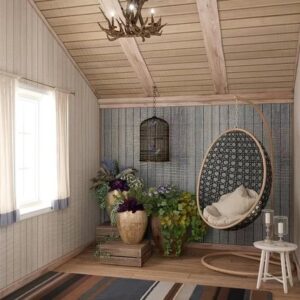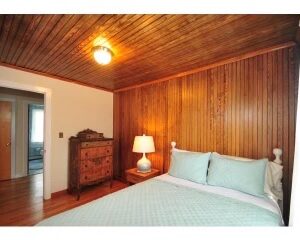Hi All,
I have some old oak/tongue and groove paneling in a portion of my house that were stained with a walnut stain and topped with an oil polyurethane about 30 years ago. I would like to brighten the space up because it is currently too dark looking, but for a variety of reasons, we don’t want to remove the paneling, or put sheetrock over it as many people suggested, or even paint it a solid white. Instead we have been looking at a staining the wood with a white/whitewash/pickling white stain. I have ordered two different varieties (General Finishes & Old Masters) of oil-based gel stain to test out, but I was wondering if anyone had any experience with these products, or if they could recommend something else. For the topcoat, we think we are going to go with something water-based that will not yellow over time. Please let me know any thoughts. I have attached two photos of the wood paneled area that we want to re-stain as well as (what I think is) a cool photo of stained wood (with what appears to be one whitewashed wall on the left) to give everyone an idea of the look we like. Looking forward to hearing everyone’s thoughts!


















Replies
For raw wood I'd go with Deft Desert Oak White. I did my floors with it 30 years ago and it's still beautiful. I topcoated with a moisture-cure poly.
To cover something that's just scuffed I'd mix acrylic white paint with a water-based poly. Test of course. I've done this many times with a nice see-through result.
Thanks for your response. Is the color that you mention still available? I took a look online and could not find it. I just ordered some Old Masters pickling white wood stain as well to test.
Many people have suggested painting the wood a solid white color, but I don't think it's a good idea because I think at best it will look a bit too DIY and will never have the clean look of newly installed shiplap for example.
Not sure if the color is still out there... I guess that can is pretty olde at this point. It is (was?) a chalky suspension & took a lot of effort to keep a wet edge and blend in the floor. With your ceiling having lines it should be easier. Test out the paint/poly mix, it goes on relatively transparent depending on the ratio. Last time I did it was for a woven ceiling and went 2:1 poly-to-paint.
I was about to push everything through the drum sander when the better half walked through the shop towards the laundry room and commented on the "beautiful texture" we all know as bandsaw marks. I agreed immediately.
It may be too late, but I feel compelled to reply to this.
Given my 40+ years as a working remodeling professional I will say IMO what you want to do is simply impossible. If you were to apply any kind of wash to those orange walls you would only end up with some type of grotesque cantaloupe colored walls, not the gray undertone you are aspiring for.
You seemed to have missed that mj said for bare wood he wood he has used the Deft. You wood is probably stained and definitely sealed you seem to think with an oil based poly. If that is the case the surface needs to be at the minimum scuff sanded because poly forms an insoluble film that relies on mechanical adhesion for subsequent layers, unlike shellac and lacquers. Even after scuffing you still will have orange walls and little hope of achieving the look you want.
The only solution that I can see to get something similar is to prime, apply a mid gray base followed by successive coats of lighter grays and whites. I have done this with a modified brush where I would cut away most of the bristles of a 4" brush so that it leaves thin lines and then just build layers of progressively lighter colors to simulate woodgrain. It is a slow tedious process and I'm just talking about the wall.
The ceiling is the deal breaker for me. There is a reason Michaelangelo painted the Sistine Chapel ceiling lying on his back on a scaffold. It is humanly impossible to work overhead for any period of time, your neck, shoulders and arms will give out before you make a dent into that ceiling. Then if you manage to get it sanded somehow how do you finish it? Finishing requires working with wet edges and it's not possible to move a ladder fast enough to do that. Even a scaffold would be limiting. Maybe if it was wheeled and you had a helper pushing you around or had access to or rented a mobile work platform but I'm skeptical that even that would be possible.
To sum this up, I doubt any professional would take this job on and if they did they would charge more than it would cost to tear the wood out and replace it with new.